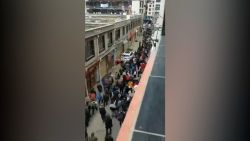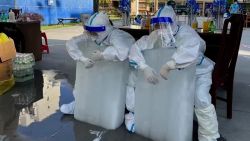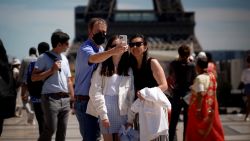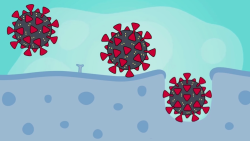A version of this story appeared in the June 9 edition of CNN’s Coronavirus: Fact vs. Fiction newsletter. Sign up here to receive the need-to-know headlines every weekday.
New York City, once the US epicenter of the coronavirus pandemic, is beginning to reopen.
After months of battling a devastating Covid-19 outbreak — which killed more than 500 people daily in the city at its peak — the Big Apple is officially back in business. Monday marked the first phase of New York’s four-part reopening plan, when manufacturers and the construction industry returned to work.
“This is a triumphant moment for New Yorkers who fought back against the disease,” NYC Mayor Bill de Blasio said. “My message is to stick to it.”
But that may be easier said than done. Almost half of US states are seeing higher rates of new coronavirus cases since lockdowns have lifted.
And there’s proof that the global crisis is “far from over.” The number of coronavirus cases hit a new daily high on Sunday, the World Health Organization (WHO) said, warning that the situation is “worsening” worldwide and the pandemic has yet to reach its peak in central America.
While successes in limiting new infections in Europe and Asia suggest it is possible to keep the virus at bay, disease experts still caution that some degree of social distancing will need to remain in place until a vaccine is available.

YOU ASKED. WE ANSWERED
Q: When will a Covid-19 vaccine be available to the public?
A: No one’s sure yet, but the target is sometime in early 2021. Vaccines in development around the world are in various stages of testing. Dr. Anthony Fauci, director of the National Institute of Allergy and Infectious Diseases, said he’s confident one of the vaccine candidates will be proven safe and effective by the first quarter of 2021. But it’s not clear which candidate shows the greatest promise yet. Holly Yan breaks down where we stand on getting a vaccine — from development challenges, to the dangers posed by an expedited process, the companies trying to deliver an immunization and just how effective it might be.
Send your questions here. Are you a health care worker fighting Covid-19? Message us on WhatsApp about the challenges you’re facing: +1 347-322-0415.
WHAT’S IMPORTANT TODAY
It’s confirmed: America’s economy has entered recession
The US officially entered a recession in February 2020, ending the longest expansion on record as the coronavirus outbreak brought economic activity to standstill. In spite of the downturn, US stocks have surged, erasing 2020 losses as investors bank on the American economy recovering quickly from the pandemic.
But China paints a different picture of the path that lies ahead. The first country to be affected by the virus — and to apparently tame it — is still trying to dig itself out of a steep economic slump more than a month after reopening.
And, even as more countries get back to business, the financial impact of the coronavirus is inescapable — the World Bank predicts the globe will have its deepest recession in 80 years, contracting by 5.2% in 2020.
Shutdowns prevented 60 million US cases
If large-scale shutdown policies — such as ordering people to stay home and closing schools — were not implemented from the beginning of the pandemic until early April in the US, there would be roughly 60 million more coronavirus infections across the nation, a new study suggests. The researchers also examined the impact of measures in China, South Korea, Italy, Iran and France, which they estimated prevented a total of 500 million infections, when combined with the US.
Though the research did not include an analysis on Covid-19 deaths, a separate study that also published yesterday examined the toll in Europe. That study, from Imperial College London, concluded that lockdown measures in Western European countries averted about 3.1 million deaths through early May.
Coronavirus came to California multiple times
A new genetic study suggests the coronavirus was carried into California several times by travelers, and that the state missed several opportunities to use contact tracing to stop further spread.
It’s a small analysis, but helps paint a picture of how a few cases can turn into a pandemic — and how quick action can stop the spread.
Asymptomatic spread ‘appears to be rare’
The spread of Covid-19 by someone who is not showing symptoms appears to be rare, Maria Van Kerkhove, the WHO technical lead for coronavirus response, said during a media briefing in Geneva yesterday.
Van Kerkhove also said that what appear to be asymptomatic cases of Covid-19 often turn out to be cases of mild disease.
ON OUR RADAR
- Universal Orlando in Florida has cautiously reopened, with social distancing measures enforced in its theme park. But will people return?
- Canada will ease border measures for immediate family members of citizens and permanent residents, including some who have been trying to enter from the US. But a 14-day mandatory quarantine remains in place.
- More than 50,000 people have now died in the UK after contracting Covid-19, according to the respective national statistics offices of England and Wales, Scotland and Northern Ireland.
- India’s coronavirus cases are continuing to climb. The biggest single-day jump in reported infections coincided with the “Unlock 1” reopening phase on Monday.
- The oil giant BP has announced plans to cut 10,000 jobs worldwide; the company says it needs to reduce costs because of a plunge in the price of oil caused by a drop in demand due to the pandemic.
- For intrepid tourists willing — and legally able — to hit the road, or locals seeking a staycation, luxury hotels in Asia are offering stellar deals.
TOP TIPS
Self-care. In the midst of an intractable pandemic, lengthy lockdowns and mass protests against racism, it may be the last thing on your mind. But in a time of unrest and uncertainty, establishing a wellness routine is more important than ever. And, while you’re stuck at home, it’s an opportune moment to get started. Health experts say it’s important to create a manageable routine that you can stick with as part of a lifestyle — not something overly ambitious that you can’t sustain. One way to do that is to start small and build upon it, as you feel comfortable. Lisa Drayer has these tips for successful rituals you can practice from morning to night.
TODAY’S PODCAST
“On a flight, wearing goggles can’t hurt, especially if it might stop you from touching your eyes, which is a big problem.” — CNN’s Chief Medical Correspondent Dr. Sanjay Gupta
From washing masks to house visits and summer travel, Gupta tackles some recent questions from our listeners. Listen Now.
















